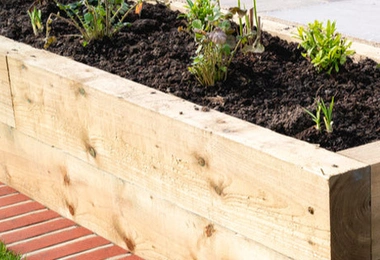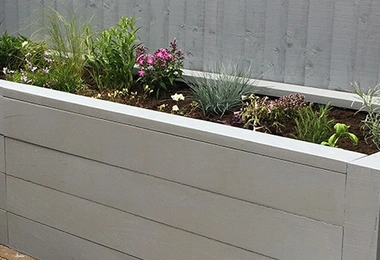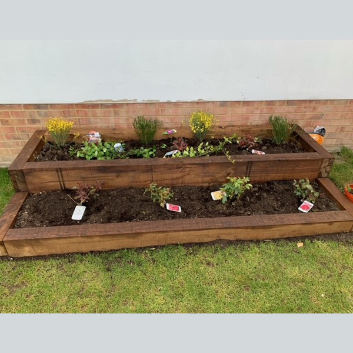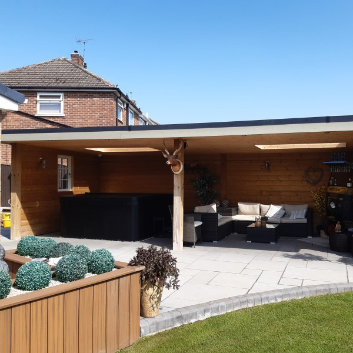Check local branch stock
-
Special Offer
![Green Incised Softwood UC4 Treated Sleeper Green Incised Softwood UC4 Treated Sleeper]()
![Green Incised Softwood UC4 Treated Sleeper Green Incised Softwood UC4 Treated Sleeper]() Special Offer
Special OfferGreen Incised Softwood UC4 Treated Sleeper
£9.95 - £36.48 each (Ex VAT)£11.94 - £43.78 each (Inc VAT)Sleepers are a fantastic multipurpose feature for garden and landscaping projects. Popular uses include raised garden beds, pathways, edging or borders, steps, and even fences or walls. These incised softwood sleepers are made from European softwood and... -
Special Offer
![European Untreated Oak Garden Sleeper 100 x 200 x 2400mm European Untreated Oak Garden Sleeper 100 x 200 x 2400mm]()
![European Untreated Oak Garden Sleeper 100 x 200 x 2400mm European Untreated Oak Garden Sleeper 100 x 200 x 2400mm]() Special Offer
Special OfferEuropean Untreated Oak Garden Sleeper 100 x 200 x 2400mm
Sleepers are always a popular product due to their versatility. They are often used as garden retainers, horizontally or sometimes dug into the ground and used vertically. Other popular applications are for steps and increasingly for growing vegetables... -
![Green Redwood UC4 Treated Garden Sleeper 100 x 200 x 2400mm Green Redwood UC4 Treated Garden Sleeper 100 x 200 x 2400mm]()
![Green Redwood UC4 Treated Garden Sleeper 100 x 200 x 2400mm Green Redwood UC4 Treated Garden Sleeper 100 x 200 x 2400mm]()
Green Redwood UC4 Treated Garden Sleeper 100 x 200 x 2400mm
Sleepers are a fantastic multipurpose feature for garden and landscaping projects. Popular uses include raised garden beds, pathways, edging or borders, steps, and even fences or walls. These incised softwood sleepers are made from European softwood and... -
![Green Softwood UC3u Treated Sleeper FSC Green Softwood UC3u Treated Sleeper FSC]()
![Green Softwood UC3u Treated Sleeper FSC Green Softwood UC3u Treated Sleeper FSC]()
Green Softwood UC3u Treated Sleeper FSC
£35.90 - £36.30 each (Ex VAT)£43.08 - £43.56 each (Inc VAT)Sleepers are always a popular product due to their versatility. They are often used as garden retainers, horizontally or sometimes dug into the ground and used vertically. Other popular applications are for steps and increasingly for growing vegetables... -
![Brown UC3u Treated Sawn Garden Sleeper 125 x 250 x 2400mm Brown UC3u Treated Sawn Garden Sleeper 125 x 250 x 2400mm]()
![Brown UC3u Treated Sawn Garden Sleeper 125 x 250 x 2400mm Brown UC3u Treated Sawn Garden Sleeper 125 x 250 x 2400mm]()
Brown UC3u Treated Sawn Garden Sleeper 125 x 250 x 2400mm
Sleepers are always a popular product due to their versatility. They are often used as garden retainers, horizontally or sometimes dug into the ground and used vertically. Other popular applications are for steps and increasingly for growing vegetables... -
![Brown Charred Brushwood UC3u Treated Garden Sleeper 125 x 250 x 2400mm Brown Charred Brushwood UC3u Treated Garden Sleeper 125 x 250 x 2400mm]()
![Brown Charred Brushwood UC3u Treated Garden Sleeper 125 x 250 x 2400mm Brown Charred Brushwood UC3u Treated Garden Sleeper 125 x 250 x 2400mm]()
Brown Charred Brushwood UC3u Treated Garden Sleeper 125 x 250 x 2400mm
Sleepers are always a popular product due to their versatility. They are often used as garden retainers, horizontally or sometimes dug into the ground and used vertically. Other popular applications are for steps and increasingly for growing vegetables... -
![Brown Softwood UC3u Treated Garden Sleeper 95 x 195 x 2400mm Brown Softwood UC3u Treated Garden Sleeper 95 x 195 x 2400mm]()
![Brown Softwood UC3u Treated Garden Sleeper 95 x 195 x 2400mm Brown Softwood UC3u Treated Garden Sleeper 95 x 195 x 2400mm]()
Brown Softwood UC3u Treated Garden Sleeper 95 x 195 x 2400mm
Sleepers are a fantastic multipurpose feature for garden and landscaping projects. Popular uses include raised garden beds, pathways, edging or borders, steps, and even fences or walls. These brown softwood sleepers are made from softwood and pressure... -
![Rustic Redwood UC3u Treated Garden Sleeper 100 x 200 x 2400mm Rustic Redwood UC3u Treated Garden Sleeper 100 x 200 x 2400mm]()
![Rustic Redwood UC3u Treated Garden Sleeper 100 x 200 x 2400mm Rustic Redwood UC3u Treated Garden Sleeper 100 x 200 x 2400mm]()
Rustic Redwood UC3u Treated Garden Sleeper 100 x 200 x 2400mm
Redwood sleepers can be used for pathway edges, steps, path steps , benches and much more only your imagination limits the uses! Made from more durable redwoods and pressure treated.
Garden Sleepers
What are Garden Sleepers?
Garden sleepers are a traditional bedding piece that sits flat on top of the earth, grass, pavement etc and supports itself. It is different to a joist which is placed horizontally along its edge and typically supported at both ends.
Although now a popular part of landscaping, they are referred to as “railway sleepers” due to their historic use to support tracks across our railway networks. These days, garden sleepers have generally been replaced by concrete alternatives.
Uses for Timber Sleepers:
There are many common things that sleepers for the garden can be used for including:
- To define borders and garden edging
- Create raised bed sleepers and planters
- Seating
- As the perimeter for ponds and garden features
- Play pits and sandpits
Whilst timber sleepers can be used as a shed base or to build steps, they are typically too expensive for either of these and not worth it
At Howarth Timber, we offer a wide range of sleepers for the garden, including:
- Sawn Green Treated Sleepers
- New European Oak Sleepers
- Rustic Redwood Sleepers
Please Note: The sleepers you receive may not be cut perfectly square at the ends, which makes it difficult to guarantee measurements will be as stated. This should be taken into consideration before purchasing.
The timber used is a natural product and may include knots in the grain, which will affect the overall appearance of the sleeper.
If you want to know how to build a raised garden bed with sleepers, we have created a guide for you. Click here to find out more.
Frequently Asked Questions
How to guides

How to fit railway sleepers together
Read our article on how to fit railway sleepers together including a checklist of what you will need for the job.

How to build a raised garden bed with sleepers
How to build a raised garden bed with sleepers using our timber products.
Customer Inspiration




















